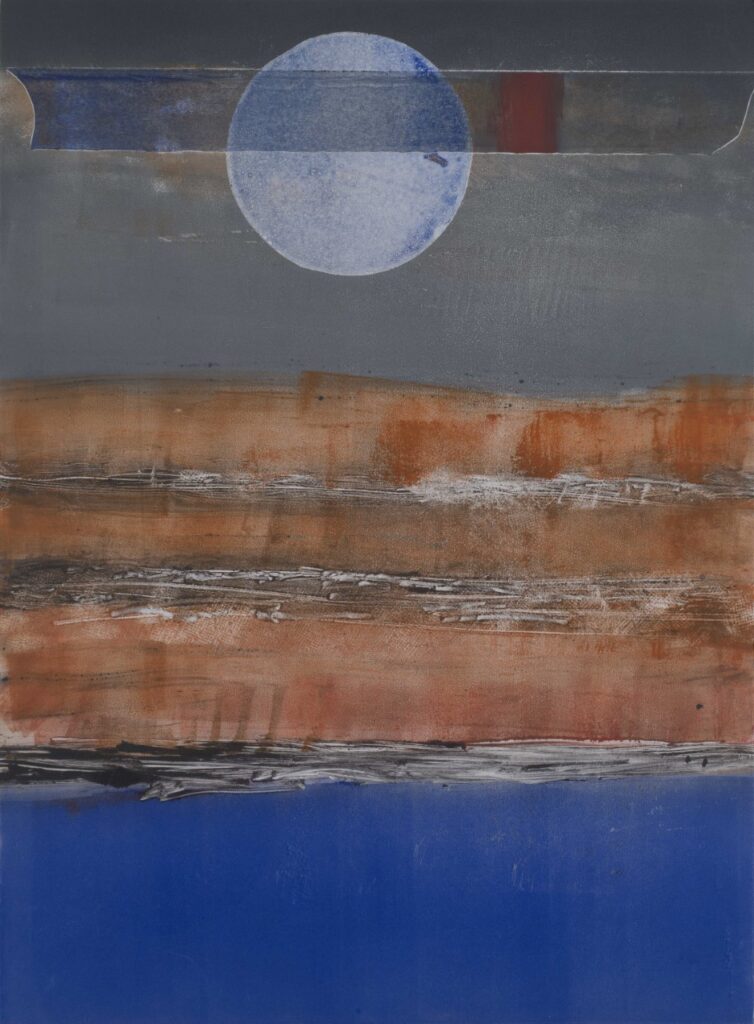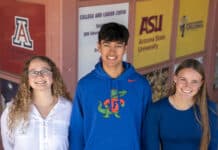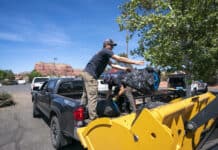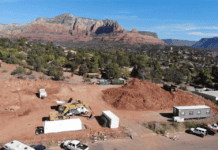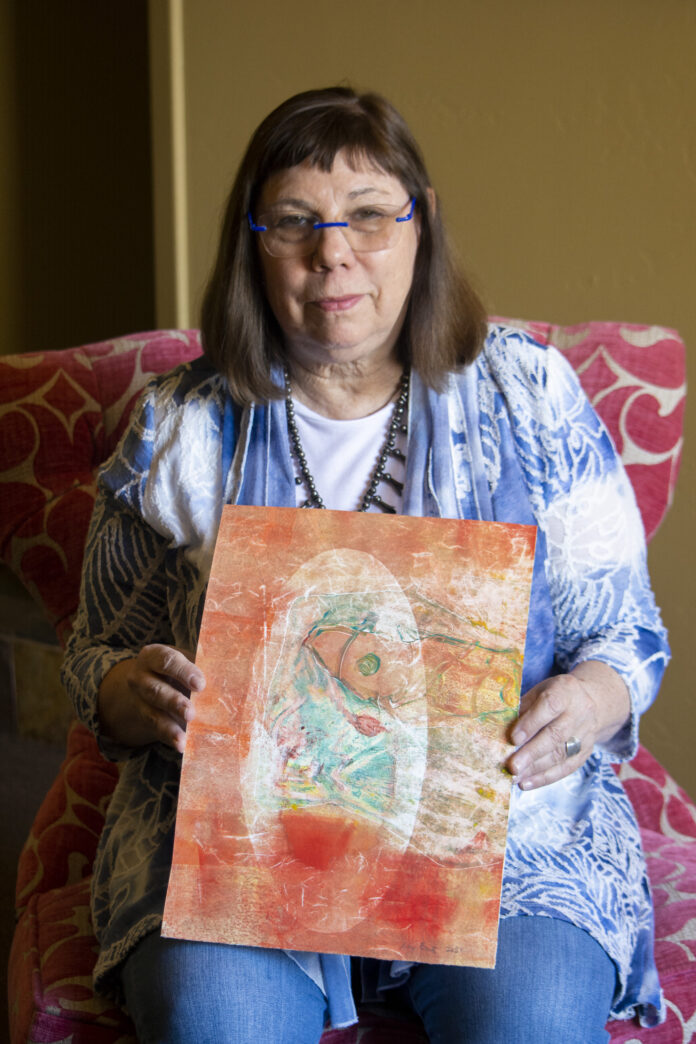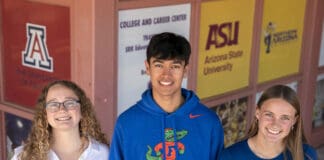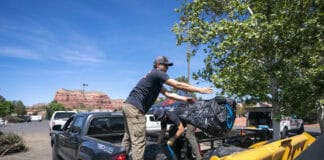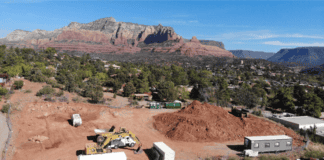Amy Ernst’s life reads like a Who’s Who in American art and culture. She is the great-granddaughter of portrait painter Philipp Ernst, granddaughter to the pioneer of the Dada and Surrealist Movement and prolific artist Max Ernst and daughter to abstract painter Jimmy Ernst. She was born into one of the most influential art families of the 20th century — and it should be no surprise that Ernst is an artist as well — creating colorful collages and monoprints juxtaposed with surreal mystical imagery and influences of the Renaissance.
Ernst’s connection to Sedona runs deep. She was recently in town celebrating her 69th birthday and reconnected with a historic landmark on Brewer Road that she once called home. The Brewer Road home was where she and her family lived during the late 1950s and early 1960s when Ernst was in elementary school. She said that she vaguely remembers walking to school and feeding a donkey along the way. Her father, Jimmy Ernst, was a teacher at the Sedona Art Center and her mother, Dallas, was a potter and sculptor who took classes from Charles Loloma, a Hopi and master potter, painter and jewelry designer. Dallas developed a unique glazing technique that complemented the abstract forms she devised for her ceramic vessels.
During Amy Ernst’s visit to Sedona, she had the opportunity to visit her childhood home that was recently purchased by Mark Rownd, a Sedona artist, musician and art historian of both Max Ernst and Dorothea Tanning. The tiny abode was home, not only to Amy and her parents, but to her grandfather Max Ernst and Tanning who built the home in the 1940s and lived there until 1953. Tanning had named it “Capricorn Hill.
” It became the site of Max Ernst’s monumental masterpiece “Capricorn,” where it stood guard over the home. That sculpture was originally constructed in cement from castings of milk bottles, automobile springs and other discarded items. It later was duplicated into a bronze sculpture and now resides at the Smithsonian.
Amy Ernst said that the home looked different than what she remembered as she traced bits and pieces of her past.
“My family history has always been a mystery to me,” Ernst stated. “I had to rely basically on people like Mark [Rownd] who I’ve just met not too long ago to tell me things that I didn’t know or to meet people and art dealers who had met Max and Dorothea or my parents and most of them are gone now.”
While in Sedona, Ernst got the lay of the land, visiting places where her family had been before.
“Each moment that I stepped out of the casita, there was something that made me feel that this is the place I need to be — maybe not all the time,” Ernst said. “But honestly, each moment that I was taken on a walk or a drive, the feelings I got from the people that I met and the energy that I felt, [made me think that I need to make Sedona my home as well].
As an artist, Ernst has been compared to her famed grandfather and father. While her work resembles that of her family’s, her art is her own. “I am walking my own path, not the path that my father or my grandfather walked — but my own,” she said.
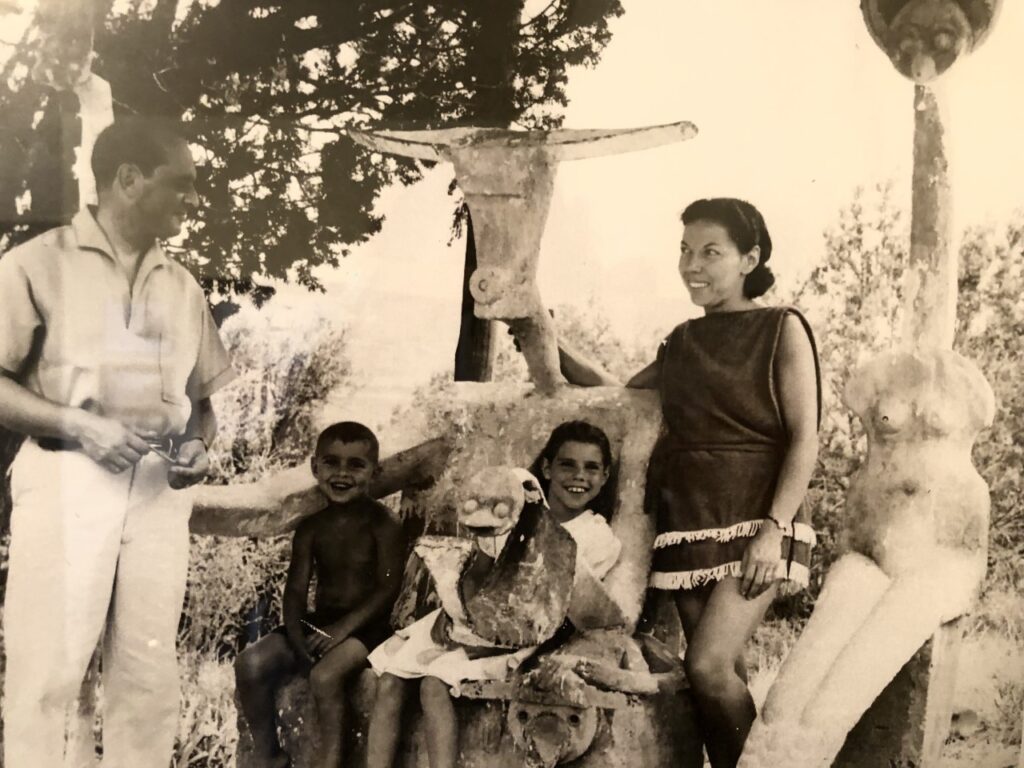
Three Generations
In 1919, Max Ernst created some of his first surrealistic pieces of artwork, using a variety of mediums — painting, collage, printmaking, sculpture and various unconventional drawing methods — giving visual form to his own world of dream and fantasy. By combining his illusionistic techniques with a cut-and-paste logic, he made the incredible surrealism — believable.
Jimmy Ernst turned to Abstract Expressionism during the time of Jackson Pollock, Mark Rothko and Willem de Kooning. In the 1960s and 1970s, Ernst worked in a linear and geometric style, producing paintings that incorporated symbology, mostly American Indian symbols, inspired by the art that he saw while living in Sedona.
While Amy Ernst uses similar techniques to both her grandfather and father, she has her own unique symbolism, drawing from Flemish and Renaissance period art.
“I’m fascinated with medieval art, angels, found objects and the Madonna as well as windows. I also tend to focus on eyes — eyes are haunting to me,” Ernst said “Maybe because I have a problem with my own eyes.”
Ernst has retinal dystrophy, a genetic disorder that causes trouble focusing on things for long periods of time. She said the disorder has also affected her reading abilities.
“It’s not like I can’t read,” she said. “It’s very difficult for me to read whole sentences and so, with my artwork, images become more abstract and they become less precise. And I tend to work well listening to music because that helps me tremendously.”
Over the years, Ernst has experimented with different forms of art, with printmaking and collage work the primary focus. Creating books out of old cigar boxes and found objects, has been her most innovative. Typically, she has five to seven projects going on at the same time and it could take as much as one year to complete a piece of work.
“I’ve never considered myself a painter,” she said. “I’ve done a lot of painting and I used to do these little pieces, but then they always ended up as collages. Typically, I would work on a piece and then deconstruct it and then it becomes something else.
“I always felt that I wanted people to experience my work like they were walking into it, not just viewing it from a two-dimensional surface, but being a part of it. I’ve never considered anything I do as a masterpiece.”
Ernst has said that she has been compared to her father and her grandfather and finds that some galleries tend to be more interested in what she can bring to the table of their work instead of her own. That can be challenging especially when she wants to be recognized for her own work, not that of her family.
“[One of my goals] is to be recognized for my own work and not just because of the last name and the genes,” she said. “The other goal is to have my own museum exhibit one day. I am who I am, I accept it, I have no problem, working through it.”
“I didn’t start out being an artist, nor did I want to be one. I was interested in the theater,” she said. She started working in the theater at 14, in East Hampton, N.Y., at the John Drew Theater under Edward Albee, then with the Yale Repertory Theatre.
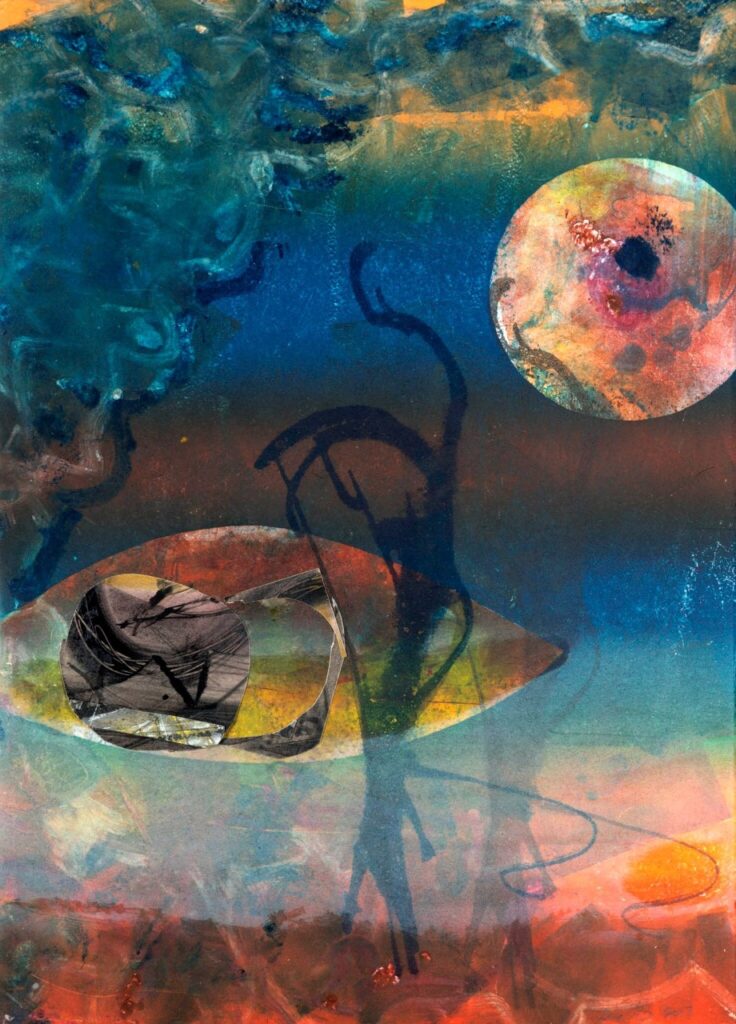
Art Exhibitions
In 2020, Ernst participated in 31 Women Artists, a special exhibition at the Sedona Arts Center. This exhibition was curated by Catriona McAra, Ph.D., University Curator at Leeds Arts University in England. McAra published extensively on the art and literature of Tanning and Leonora Carrington with an interest in feminist aesthetics and surrealist legacies in contemporary practice. McAra selected 25 contemporary women artists out of 220 applications. In addition to Ernst, works from Tanning and Carrington were also a part of the exhibit.
That exhibition paralleled another famous art show that took place 77 years prior. In 1943, Peggy Guggenheim launched Exhibition by 31 Women at her Art of This Century Gallery in New York City. The show was curated by her then-husband Max Ernst and featured work from artists Tanning and Carrington.
As Amy Ernst begins to slowly step out of her comfort zone, she says that she is using this time to rediscover herself and has always wanted people to “just accept me for me.”
“[My father], he was very much his own artist,” Ernst said. “And I’ve always wanted to be my own person and it’s taken me many years to realize I always have been — like we all are. Yes, it’s good to give yourself permission. I’ve been waiting for someone to give me permission — and nobody’s going to do that. I’ve also been afraid of people’s reaction because I don’t want to disappoint them.”
While the red rocks of Sedona have captured Ernst’s attention, she says that she has always been drawn to the ancients and perhaps she belongs here.
The energy of Sedona, is no secret to her legendary family — it’s what they observed many years prior and attributed to their renowned artwork that is displayed in museums globally.
“I’m feeling more and more connected with Sedona. It’s not just memories as a 6- or 7-year-old or even a 19-year-old, but it’s a community that I’ve missed [being around] so many years of my life. I want to spend quality time with people here and we are just getting to know one another.”
